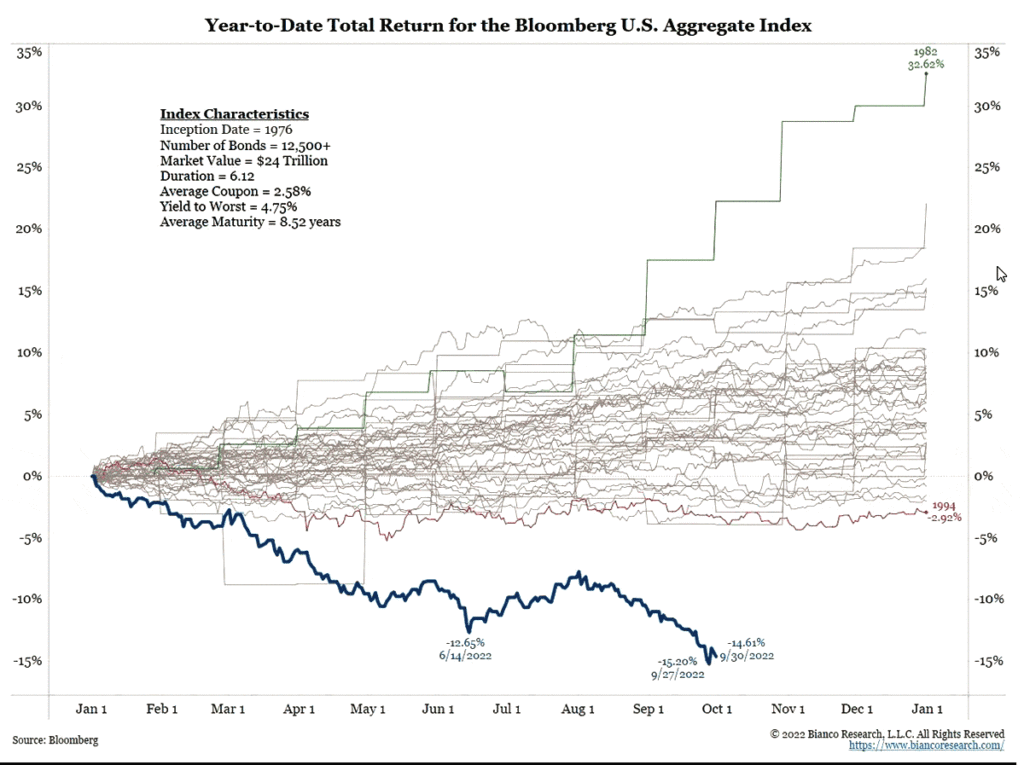One of the origins of the age-old adage “this too shall pass” is credited to Jewish folklore, which recently came up in conversation with a client during Rosh Hashanah. The phrase was attributed to King Solomon in the mid-19th century.
September 22nd marked the Autumnal Equinox, which means fall is officially here. Time for pumpkin spice everything, crisp air, and Halloween. The transition into fall got me thinking about how the seasons of life come to pass – both the good and the bad.
As we bid summer farewell, I can’t help but reflect on how markets have fallen this year. On the heels of the massive liquidity that the Fed, Treasury, and Congress pumped into the economy—which catapulted stock, bond, and real estate valuations higher—the monetary policies that aimed to alleviate the COVID selloff and help the economy through forced shutdowns have culminated in an inflationary environment that this country hasn’t seen in roughly 40 years.
Bad news is at every turn. The S&P500 is back in bear market territory. Bonds are having by far their worst year for anyone who is alive today. The Fed came out two weeks ago with a stern warning for investors: it is reportedly unwavering in its commitment to raising interest rates to combat inflation. Many C-suite executives are planning on Q4 layoffs. China is still shut down. The war in Ukraine rages on.
Our concern is that the Fed will overdo it, forcing domestic and global economies into recession. Much of the explanation is too technical to write about here, but we are discussing specifics in client reviews. At a high level, though, here’s how we’ve been weathering the storm:
Increasing Cash
The colloquial phrase “cash is king” is nothing new. The problem with staying in cash for too long is that we risk losing to inflation. For example, if inflation is 8% for a year and we are in all cash, we maintained our principal but lost 8% of our purchasing power. That said, having some dry powder in an environment like this can be healthy for deploying into specific sectors when certain trigger points are met. Given the rise in interest rates this year, we are now able to earn 2%+ on money market funds which wasn’t possible until recently.
Decreasing International Stocks
With the U.S. dollar at a 20-year high relative to foreign currencies, we have reduced the allocation to international stocks. As the Fed continues to raise interest rates, this likely means an even stronger dollar, which can serve as a headwind for international equity markets.
Alternative Investments
In many of our portfolios, we’ve already had a merger arbitrage alternative investment that historically has helped reduce portfolio volatility. Considering this year’s environment, we began incorporating a market neutral alternative investment a few months ago. The objective is to try and smooth out the ride as this inflationary rollercoaster evolves.
Tilting Toward Value
We have been tilting toward stocks and exchange-traded funds (“ETFs”) of so-called value companies, many of which have historically increased their dividends. The goal is to allocate to companies with good cashflows, healthy balance sheets, and sustainable businesses. Many of these names were less popular among investors during Quantitative Easing (“QE”) when the high-flying tech sector seemed to only go up as the Fed maintained record low interest rates for many years. Tilting toward value is a defensive play and having an allocation to names that have historically raised their dividends helps combat inflationary pressures. People have a fundamental need food and shelter, not $7 cups of coffee or $140 yoga pants.
Modifying Bond Exposure
We have been exiting bond funds and rolling into individual treasury bonds. Given the rising interest rate environment, we are now able to obtain yields from individual treasury bonds that were much less attractive at the beginning of the year when interest rates were lower. This strategy is known as a bond ladder.
For example, instead of allocating to a bond mutual fund with a yield of, say, 2.9% that has the potential to lose principal as rates rise (we’ll spare you the bond math), we buy individual treasury bonds (“T-bills”) with differing maturities that mature at par. We can now get a 3-month treasury bond yielding an annualized 3.2% and a 6-month treasury bond yielding an annualized 3.8%. The objective is to preserve capital as rates rise. Yes, we like bond mutual funds, but we prefer to allocate to them in a steady or decreasing interest rate environment, whereas we prefer to allocate to individual bonds in a rising interest rate environment.
To put the bond market’s performance into context, here is a graph showing you how bad the U.S. bond market has gotten beaten up this year. The data includes year-to-date returns through September for the Bloomberg U.S. Aggregate Bond Index starting in 1976. The obvious outlier, which is this year, is the blue line at the bottom:

As the graph above shows, year-to-date performance for the Bloomberg U.S. Aggregate Bond Index is down…get ready for it…about 15%. The second-worst year is 1994 when the index was down just shy of 3%. Importantly, this means that bonds have not served as a ballast in portfolios this year as stocks have sold off, with the S&P500 down approximately 25% on the year through September. Thus, bonds have not helped buffer portfolios against the downside volatility in stocks. You can “thank” the Federal Reserve for this.
This has been a rough year, to say the least. Unlike most of the market selloffs since 2008, the Fed has not stepped in with more quantitative easing and cutting interest rates to zero; on the contrary, the Fed has continued to raise rates. No one knows specifically how long this will last. It is our view that the Fed will continue to raise rates until it either sees consistent proof of inflation decreasing or there is evidence of real systemic risk in financial markets, which may cause the Fed to pivot and pump the brakes on hiking rates.
Either way, we may experience more volatility. A Fed pivot, which is a scenario wherein the Fed changes its current course and reverts to accommodative monetary policy, would be a pleasant surprise. Should that happen, inflation would likely continue to run at an elevated level. Timing a Fed pivot is virtually impossible, but we continue to watch for signs of a change in monetary policy. Should one occur, we’ll advise you of resulting portfolio tweaks.
In the meantime, try to enjoy all things pumpkin spice and Halloween, and let’s hope the markets don’t get any more ghoulish this fall. Remember, this too shall pass, and for more on financial planning strategies we’re employing now, please read Strategies for a Bear Market.
All my best,
Vance
